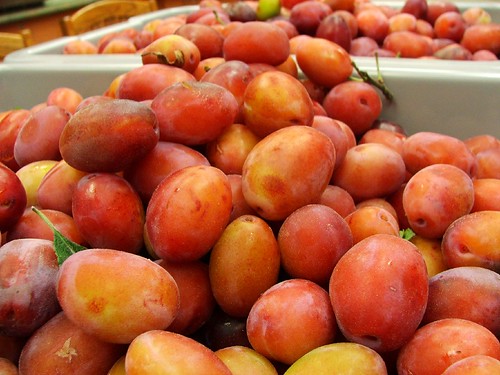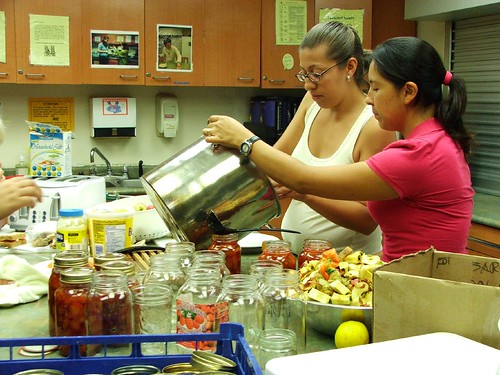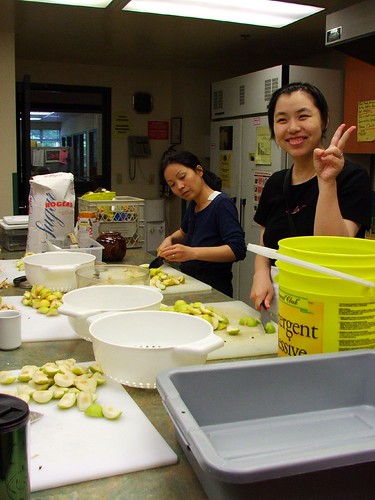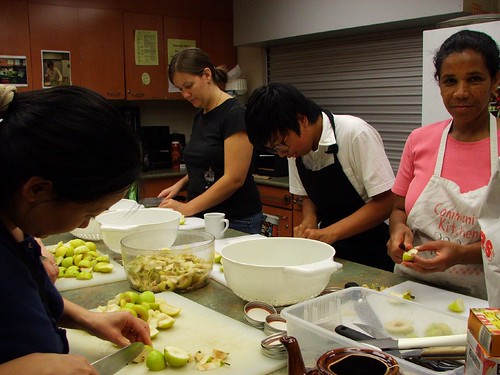
Some of the 125lbs of plums donated to our programs from the nice people at The Vancouver Fruit Tree Project.
Modern canning (including the dazzling selection of canned goods and bottled sauces found at your local grocery store) represents thousands of years of human ingenuity. Since prehistoric times, our ancestors have been trying to preserve surplus food for hungry times ahead. Some of the techniques humans have developed include: drying, smoking, or freezing in ice or snow.
In 1795, the French government offered a prize to anyone who could invent an improved method of preserving food. Nicolas Appert won the prize by packing fruits, vegetables, and meats into glass bottles without air and processing the bottles in boiling water.
For the next 6 decades or so, people experimented with different canning methods and materials (such as lead and tin). Some of these experimental canning methods were difficult, expensive, or unsafe. Bacteria was not understood well, and contamination was common. Illnesses and even death could result from eating canned goods.
In 1858, a 26-year-old American named John L. Mason invented the mason jar. This was a glass jar with a resealable metal lid. Mason's invention made home canning relatively safe, as the jars had durable vacuum seals to trap out bacteria. The inexpensive screw-on lids made the jars truly reusable--and revolutionized the home canning process.

Wild blackberry-Asian pear jam and fig jam in modern mason jars.
The mason jar was invented around the time that inexpensive sugar became widely available in the United States. Thus, for the first time, the average homemaker was able to preserve seasonal bounty for use through the hungry winter and early spring. Home canning improved nutrition and meal variety, even for those who were not wealthy.
The mason jars we use today have not changed very much since John Mason's time. However, there have been several refinements around the canning process; scientific research and data collection has allowed us to understand the risks of home canning better than in the past. Some traditional family recipes or methods are not recommended for use today. We'll talk about these issues in a blog post on "Tips for Successful Canning," coming soon.
Home canning skills were once extremely common--but on the market today, we find many safe and inexpensive commercial canned goods. Some of these products contain a lot of salt or chemical preservatives--but they are so convenient that most busy urban folks have forgotten home to can food at home.

Liliana and Mirabel ladling plum preserves into hot sterilized jars.
Lately, the Food Security Institute has been receiving large donations of surplus fruit from generous local residents and Collingwood Neighbourhood House employees. We have received more than 200 pounds of fresh plums, as well as figs, apples, Asian pears, and (Western) pears. This fruit has distributed directly to families who having a hard time financially, or it is used in our many different food programs.

This overwhelming generosity has also underlined the importance of extending the season's bounty through the winter months. Even with all of our food programs, how can we use up so much fruit before it goes bad? We hate to see food go to waste so...
Using donated fruit as well as donated mason jars, we have been sharing food preservation skills and stories at canning workshops. The workshops are part of the Farmers' Market Nutrition Coupon Program, and priority for registration is for Coupon Program participants. Still, there is sometimes space left over, and interested people should contact me for scheduling information and to join us.

Preparing Asian pears for preserving.
While busily coring, peeling, and slicing, participants have been sharing memories of canning fruits and vegetables. Some participants made canned goods with their parents or grandparents, and some used different food preservation methods in their countries of origin.
This season's bounty has given us the opportunity to share stories and skills, and to extend the harvest to others beyond the canning workshops. For example, some of the preserves and sauces we've made have been used in the community lunch program as well as the Morning Star breakfast program. Volunteers at the lunch program served perogies with our "homemade" blueberry-apple sauce--it was a big hit with the seniors.

Program participants relate their experiences in the Farmers' Market Nutrition Coupon Project to visiting filmmakers from the Environmental Youth Alliance. You can watch the short documentary Nourishing Stories at the upcoming SUSTENANCE Festival.
The historical information in this post is taken from The Oxford Companion to American Food and Drink (2007), edited by Andrew F. Smith. Drawing from this and other sources, we'll be addressing some frequently asked questions about home-canning in an upcoming post. We'll also be offering important safety and seasoning tips for successful canning.
Do you have surplus backyard fruit, or know someone who does? Please contact the volunteers at The Vancouver Fruit Tree Project. Hopefully, some of your fruit can be donated to a charitable organization near you.
Thanks, and happy eating!

No comments:
Post a Comment